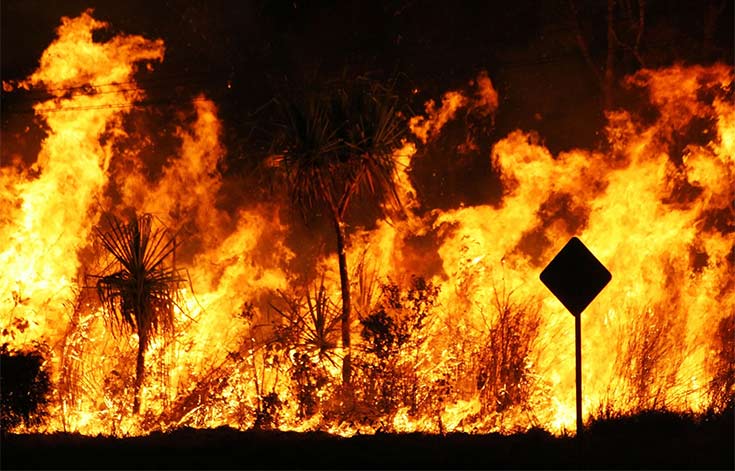Climate change and the bushfire threat in New South Wales and Australian Capital Territory
Residents of New South Wales (NSW) and the Australian Capital Territory (ACT) have often experienced the serious consequences of bushfires. In 2013, bushfires in January and October burnt 768,000 hectares of land and destroyed 279 homes in NSW. Tragically, two people lost their lives and damages were estimated to be more than $180 million.

The report says that as the bushfire risk increases, so too will the demand for resources for the emergency services (rf123/jvdwolf)
The Australian population has always lived with fire and its consequences, but climate change is increasing fire danger weather and thus the risk of fires. It is time to think very seriously about the risks that future fires will pose, says a new report from the Climate Council in Australia, an independent, crowd-funded organisation providing quality information on climate change to the Australian public.
This report provides an update to the previous Climate Council report on bushfire risk and NSW and the ACT. It begins by describing the background context of fire and its history in NSW and the ACT, then outlines the link between bushfires and climate change, before considering how bushfire danger weather is intensifying in NSW and the ACT, and what this means for the immediate future. The report further explores the impacts of fire on people, property, water supply and biodiversity, before considering the future implications of bushfires for NSW and ACT fire managers, planners and emergency services.
The report says that since the 1970s, extreme fire weather has increased across large parts of Australia, including NSW and the ACT. Hot, dry conditions have a major influence on bushfires and climate change is making hot days hotter, and heatwaves longer and more frequent, with increasing drought conditions in Australia’s southeast. The report notes that summer 2015/16 was Australia’s sixth hottest on record and in NSW and the ACT the mean maximum temperatures were 1.4°C and 1.9°C above average, respectively. February 2016 was also the driest that NSW has experienced since 1978. “Hot and dry conditions are driving up the likelihood of dangerous fire weather in NSW and the ACT,” say the report’s authors.
In NSW and the ACT the fire season is starting earlier and lasting longer. Dangerous fire weather has been extending into Spring and Autumn. 'Above normal' fire potential is expected in most of NSW for the 2016-17 bushfire season, because of high grass growth experienced during spring and predicted above average temperatures during summer.
In the ACT, predicted hotter and drier weather during summer will produce conditions conducive to bushfire development.
Record breaking heat and hotter weather over the long term in NSW and the ACT has worsened fire weather and contributed to an increase in the frequency and severity of bushfires. In October 2013, exceptionally dry conditions contributed to severe bushfires on the Central Coast and in the Blue Mountains of NSW, which caused over $180 million in damages. At the beginning of August in 2014, volunteers were fighting 90 fires simultaneously and properties were destroyed.
The total economic costs of NSW and ACT bushfires are estimated to be approximately $100 million per year. By around the middle of the century these costs will more than double, according to the report, which adds that bushfires cost an estimated $375 million per year in Australia. With a forecast growth in costs of 2.2 per cent annually between 2016 and 2050, the total economic cost of bushfires is expected to reach $800 million annually by the middle of the century.
However, the report warns that state and national projections do not incorporate increased bushfire incident rates owing to climate change and these could potentially be much higher. It points out that in 2003, abnormally high temperatures and below average rainfall in and around the ACT preceded bushfires that devastated several suburbs, destroyed over 500 properties and claimed five lives. This also had serious economic implications for the ACT with insured losses of $660 million.
“In the future, NSW and the ACT are very likely to experience an increased number of days with dangerous fire weather. Communities, emergency services and health services must keep preparing,” say the authors.
Fire severity and intensity are expected to increase substantially in coming decades, especially in those regions currently most affected by bushfires, and where a substantial proportion of the Australian population lives. As the fire risk increases, so too will be the need for increased emergency services and fire management agency resources.
“This is the critical decade to protect Australians,” according to the report, “Australia must strive to cut emissions rapidly and deeply to join global efforts to stabilise the world’s climate and to reduce the impact of extreme weather events, including bushfires.” It adds that Australia’s “very weak” target of a 26-28 per cent reduction in emissions by 2030 compared to 2005 levels leaves Australia lagging well behind other OECD countries, adding: “And we are on track to miss even this target.”
The full report can be downloaded here (direct link to PDF)